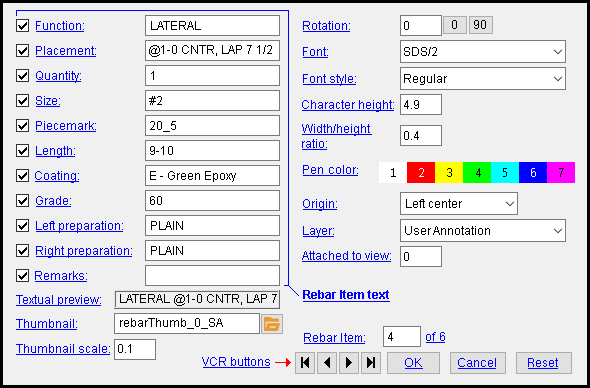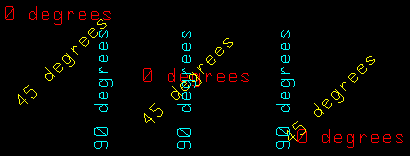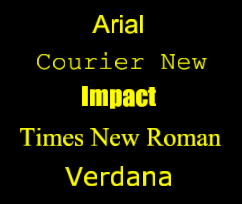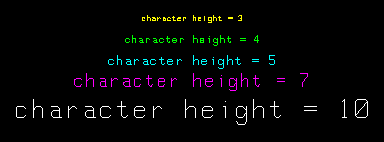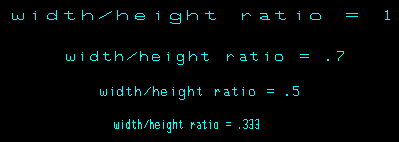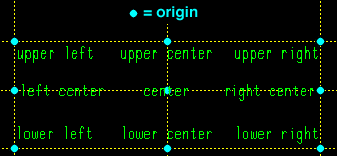The Edit Rebar Item window
|
|
Options :
To open this window :
- Objects > Rebar Items > Add
- Objects > Rebar Items > Rebar Item Combo
- Objects > Material Callout > Add
- Objects > Rebar Items > Edit or double-click a rebar item
- Edit Rebar Item (multiple)
- Rebar Items ( Display Options )
Also see :
- Label character height (also sets the default for Rebar Items )
- Label width/height ratio (also sets the default for Rebar Items )
- Label font (also sets the default for Rebar Items )
- Label font style (also the sets default for Rebar Items )
- Layer Panel (default layer for Add Rebar Item )
- Grayed out fields (indicate mixed entries or that the field is disabled)
- Multi Items Edit (related window)
page 1 | contents | objects > rebar items | top
Rebar Item text can be any string of up to 29 alpha/numeric characters. By default, the character string of the last-added or last-edited label is automatically entered to this field during an Add Rebar Item operation -- see " OK ."
Adding a Rebar Item : A Rebar Item can be added to a drawing with the Add Material Callout tool when reinforcing bar is selected that is a component or is material added to a member. In that case, information about the rebar is derived from the 3D model in Modeling (i.e., from information entered into the Edit Rebar Shape window) and is used to populate the " Rebar Item text " fields. If you add a Rebar Item using the Rebar Item Add tool, " Rebar Item text " fields are not automatically populated by the system. If you are adding a rebar item manually and there is no character string left over from a previous Add Rebar Item or Add Material Callout operation, these fields will be blank by default.
Rebar Item text fields can be toggled on (
) or off (
) by using the check box next to the field. Fields that are toggled off will not be displayed when the rebar item is placed.
Special characters can be added to " Rebar Item text " using Latin 1 characters 0160 to 0255 -- hold down the Alt key and type in the number, or copy and paste from the Character Map that can be launched from your operating system's Accessories menu. The key bindings and mappings for these fields are the same used for " Label text ", with the exception of " Enter " and " Ctrl + a ". Unlike " Label text " fields, no substitutions are made in " Rebar Item text " fields for special labels .
Required values: The values in these fields are combined into a string that is displayed both in the " Textual preview " field and when it is placed. The system will not place a rebar item without text, nor will it place a rebar item whose field is toggled off. Therefore, you must make sure that at least one of the " Rebar Item text " fields has a value in order to place the item.
Any string of 29 characters or less will be accepted by the " Rebar Item text " fields. So possible values for these fields are not limited to those described as "appropriate" below.
Rebar Item text fields
Function: Blank or any string . Any description that has been entered to the Rebar Usage Definitions window under the description table is appropriate here. When the value is automatically entered, it is derived from the value of the " Function " field in the Edit Rebar Shape window.
Placement: Blank or any string . A placement note is an approprate entry here. When the value is automatically entered, it is derived from the value entered in the " Placement note " field in the Edit Rebar Shape window.
Quantity: Blank or any string . An integer reflecting the number of rebar described by the Rebar Item is appropriate here. As only a single rebar shape material can be chosen when placing the item, this will default to ' 1 '. More pointers may be added later and the number can be incremented accordingly.
Size: Blank or any size designation that has been entered to the Rebar Definitions Setup window under the " Active rebar standard " is appropriate here. When the value is automatically entered, it is derived from the value entered in the " Template " field in the Edit Rebar Shape window.
Piecemark: Blank or any string . The submaterial piecemark of the reinforcing bar is appropriate here. The automatically entered value is the system piecemark assigned to the rebar material.
When the value is manually entered, a dimension (in the primary dimension " Units " or other units ) reflecting the either the billing or cut length is appropriate here These values are shown in the " Cut length " and the " Billing length " fields in the Edit Rebar Shape window.
When the value is automatically entered, the choice of the " Preferred rebar length designation " in the Concrete Member and Material Piecemarking window is used.
Grade: Blank or any string . Any steel grade designation that has been entered to the Reinforcing Bar Grades Setup window under the " Steel Grade " is appropriate here. When the value is automatically entered, it is derived from the value of the " Steel grade " field in the Edit Rebar Shape window.
Coating: Blank or any string . Any reinforcing bar coating designation that has been entered to the Rebar Coatings Setup window under the " Standard " is appropriate here. When the value is automatically entered, it is derived from the value of the " Coating " field in the Edit Rebar Shape window.
Left/Right preparation: Blank or any string . The end treatment applied to the left or right end of the reinforcing bar is appropriate here; e.g., ' Plain ', ' Threaded ', ' Terminator ', or ' Deformed '. When the value is automatically entered, it is derived from the value of the " Left/Right End Type " field in the Edit Rebar Shape window.
Remarks: Blank or any string .
page 1 | contents | objects > rebar items | top
Textual preview: A read-only value that displays the " Rebar Item text " values (if non-empty) in the order in which they are listed in the Rebar Items window and separated by spaces. This is the string that will be displayed in the Rebar Item when it is placed in the drawing.
For example, suppose that the only " Rebar Item text " fields with entries were the " Quantity ", " Size ", and " Remarks " fields, and furthermore, that their values are "3," "#5," and "(LAP 2-0 AT SUPPORT)," respectively. Then the " Textual preview " field will display "3 #5 (LAP 2-0 AT SUPPORT)." Empty fields or fields that are toggled off (
) will be ignored.
Thumbnail: None or a job standard detail name . To apply a job standard detail, you can type in the name of the drawing (if you know it), or you can press the "file cabinet" browse button ( ![]() ) and double-click any job standard detail that is on the list. When the value is automatically entered, the job standard detail associated with the " Template " field in the Edit Rebar Shape window is displayed here.
) and double-click any job standard detail that is on the list. When the value is automatically entered, the job standard detail associated with the " Template " field in the Edit Rebar Shape window is displayed here.
If ' none ' is entered here, then no job thumbnail is shown beneath the Rebar Item .
If a ' job standard detail name ' is entered here, the job standard detail is shown as a thumbnail beneath the Rebar Item as illustrated below.
|
Thumbnails are created automatically for the current job whenever a shape template is used for rebar material. They are named with the prefix "rebarThumb_" and are saved as job standard details. You may also create and use any job standard detail for this purpose.
Thumbnail scale: A decimal percentage of at least 0.1 and no more than 1.0 . This is the scale at which the thumbnail is displayed under the Rebar Item , provided that the " Thumbnail " field is not empty. An entry of ' 1.0 ' (100%) displays the thumbnail full-size.
Rotation: A positive or negative (-) number from 360 to -360 degrees.
|
An entry of ' 0 ' (zero degrees) sets the lettering to be horizontal.
A ' positive number ' of degrees rotates the rebar item counterclockwise from horizontal.
A ' negative (-) number ' of degrees rotates the rebar item clockwise from horizontal.
On the drawing itself, you can Ctrl -drag a rebar item to rotate it. The " Rotation " will automatically be updated on this window. Ctrl+Shift-drag does the same, but at 45 degree increments.
Font: Any font that is listed can be selected for the rebar item.
|
Tip : For a TrueType font , such as any of those shown here, set the " Font aspect ratio " to ' 0.6 ' to have the font rendered at its native width. |
Be sure to also choose the " Font style " that you want. The " Font size " sets the character height. If you select the ' SDS2 ' font, be aware that the " Pen " affects the thickness of the font when it is plotted.
Font style: The style (' Bold ' or ' Bold Italic ' or ' Italic ' or ' Regular ') of the selected " Font ." Different fonts may have different styles available to them.
Available font styles are listed alphabetically in the font style list box , and the first style that is listed for a particular font is the style that is selected by default. You may, instead of using the default, prefer to choose ' Regular ', which is generally the most popular style for a particular font. ' Regular ' is the only choice that is available for the ' SDS2 ' font. To adjust the stroke thickness of the ' SDS2 ' font, you can change the " Pen ."
Also see: " Label font " and " Label font style " in Drawing Presentation (setup) determine the font and font style that are applied automatically to rebar items that are generated during automatic detailing .
Character height: The character height (in millimeters) of letters/numbers that make up the rebar item. This value is independent of the " Drawing scale " of this drawing. Assuming that the sheet that this drawing will eventually be placed on has a scale of 1:1 and you do not re-scale the rebar items and the printer does not adjust the scale, this will be the actual height of characters on the plotted sheet.
|
Font dependencies: This applies to whatever font is selected as the rebar item " Font ," regardless of whether that font is a TrueType font or the ' SDS2 ' font.
Setup: You can set the default character height for automatically detailed member and submaterial drawings using " Labels character height " in Drawing Presentation . Labels added using Objects > Labels > Add are by default assigned the character height of the last-added or last-edited rebar item -- see " OK ."
Width/Height ratio: The width/height of the characters that make up the rebar item.
|
Font dependencies: This applies to whatever font is selected as the rebar item " Font ," regardless of whether that font is a TrueType font or the ' SDS2 ' font. For a TrueType font, a ratio of ' 0.6 ' renders that font at its native width. A ratio larger than ' 0.6 ' stretches the font. A ratio less than ' 0.6 ' compacts the font. For the ' SDS2 ' font, ' 0.4 ' is the default choice.
Setup: You can set the default font aspect ratio for automatically detailed member and submaterial drawings using Home > Project Settings > Fabricator > Detailing > Drawing Presentation > the " Sizes " tab > " Labels width/height ratio ." Rebar items added using Objects > Rebar Items > Add will by default be assigned the ratio of the last-added or last-edited rebar item -- see " OK ."
Pen color: 1 or 2 or 3 or 4 or 5 or 6 or 7 . No button is pressed if you are editing multiple rebar items that have different pen numbers.
|
|
|
The button that is pressed sets the on-screen display color of the rebar item and, if you are using the 'SDS2 ' font , it sets the printed thickness (though not the displayed thickness) of that font. |
For a TrueType rebar item font, the " Pen " affects the display color of the text while you are in the Drawing Editor , but does not affect the plotted appearance of the " Font " so long as all pens in Home > Project Settings > Fabricator > Line Weights are set to print in black. By default, all pens in Line Weights are set to print in black.
For the ' SDS2 ' Font, the pen color sets the stroke weight (thickness) of the rebar item characters. Home > Project Settings > Fabricator > Line Weights assigns a particular thickness to each " Pen ."
Origin: Lower left or Left center or Upper left or Lower center or Center or Upper center or Lower right or Right center or Upper right . The origin ( o ) of a rebar item is highlighted along with the rebar item when the rebar item is selected.
|
Examples: To orient the text block so that its origin point is at its lower left, select ' Lower left '. To center the text block over the origin point, select ' Center '.
Tip: Instead of using " Origin " to reposition a rebar item, you can Shift -drag the rebar item to a new position.
Layer: The drawing layer that the rebar item you are adding or editing is placed onto when you press " OK " to close this window. If that layer happens to be hidden (not marked " Show "), the rebar item disappears after the first Redraw .
![]()
Defaults: For an Label Add operation, the default selection (
) will be the layer that was selected on the Layer Panel before you began the operation. For an Edit Label operation, the default selection is the layer that the graphic object is currently on.
Attached to view: A number designating the view that this rebar item is attached to. This applies mainly to member details . For instance, a concrete column detail may have a main view, and views of the left and right ends, the top, etc. It may also have various section views through its center. All graphical objects that are in a particular view are assigned the same number. The only other type of drawing on which you might find multiple views is a submaterial detail .
Assigning the correct number to an object (line, weld symbol, label, etc.), prevents Shorten and Unshorten problems on submaterial details and member details . Automatically detailed submaterial details and member details are the two Drawing Editor drawing types that can have multiple views.
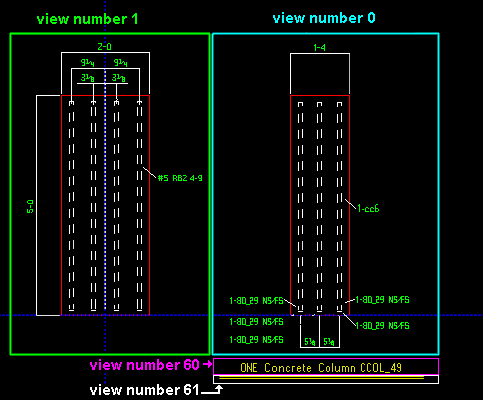
To show a view's number, you can add the X-Y-Z Display to your toolbar. An alternative decoration you can add to display view numbers is the X-Y Dual Show/True Display .

In the Drawing Editor , the X-Y-Z Display shows the view number that the point location target (
) is over.
Troubleshooting: If you Unshorten a drawing then Shorten , only to find that objects are repositioned in a way that seems wrong, the problem might be that the objects are attached to a view that is not the view that they should be attached to. A good troubleshooting method is to select all of the objects that you believe should be attached to the same view, then right-click ( Menu ) and choose " Edit " on the menu . This will open the Multi-Items Edit window. Look at the " Attached to view " field on that window. If that field is gray (shows no view number), then that field has a mixed entry , indicating that objects in your selection have have two or more different view numbers. Entering the desired view number to the " Attached to view " multi-edit field assigns all objects in your selection that one view number.
View number assignment is fairly random. While view numbers assigned during auto detailing are generally the same as the numbers assigned to views in member isolation (or material isolation's edit views mode ), there are cases where that general one-to-one correspondence will not hold. Also, while the main view of a member detail is almost always view 0, the other views are assigned numbers as they are added, and since the order in which views are added is arbitrary, there is little correspondence between a view's number and its type.
How can objects be assigned wrong view numbers? When a user adds an object to a drawing on which there are multiple views (a member detail or a submaterial detail), it is the responsibility of that user to ensure that the object is attached to the correct view. That sounds like an easy thing to do, but it isn't always so simple. Take, for example, a pointer . When a user adds a pointer using Objects > Pointers > Add , the user does not see the Pointer Edit window and therefore does not see the " Attached to view " entry field. Pointers can also be added using Paste , Paste at Original Location , Paste Repeatedly , Paste Special , Paste to Several , Add Standard Detail , Add Standard Detail to Several , Add Weld Combo , Hole Sym Combo , Label Combo , etc. Each of these tools is a different way for users to add a pointer to a wrong view.
page 1 | contents | objects > rebar items | top
For when you edit one rebar item and multiple rebar items are in the drawing :
Rebar Item _ of __ ( not applicable to Add Rebar Item or multi-edit ): The number of the one rebar item you are editing and the total count of all rebar items in your current drawing. You can use the VCR buttons to select a different rebar item and edit that rebar item's settings while still on this window. When a rebar item on a shown layer is selected, it is displayed in green (cyan if its actual color is green). The selected rebar item must be on a shown layer for it to be shown.
|
|
| VCR buttons (first-previous-next-last) for selecting a rebar item to edit. |
Note: If you change one rebar item, then select a different rebar item, the first rebar item remains changed even if you press " Cancel " on this window.
page 1 | contents | objects > rebar items | top
To close the Edit Rebar Item window :
"OK" (or Ctrl + Enter ) closes this window and completes the Objects > Rebar Items > Add or Objects > Rebar Items > Edit or Edit Rebar Item (multiple) or Objects > Rebar Items > Edit All operation.
Defaults: When you press " OK ," the settings on this window -- except mixed entries -- become the default settings for the next rebar item you Add during this session of the Drawing Editor . Even if all you do is double-click a rebar item then press " OK " without making any changes on this window, this window's settings become the defaults for the next-added rebar item.
Note: After making changes to this window and pressing " OK ," you can still undo your changes by using Revert or Undo . If you Save to make your changes permanent, you can no longer Revert , but you can still Undo .
"Cancel" (or the Esc key or the ![]() button) closes this window without saving changes you have made. In the case where you selected one rebar item for editing but changed more than one rebar item, " Cancel " only applies to the rebar item currently selected as the " Rebar Item _ of __ ."
button) closes this window without saving changes you have made. In the case where you selected one rebar item for editing but changed more than one rebar item, " Cancel " only applies to the rebar item currently selected as the " Rebar Item _ of __ ."
Defaults: The settings on this window do not become the defaults for new rebar items if you press " Cancel " to close this window (unless you used " Rebar Item _ of __ ").
Tip 1: If you used " Rebar Item _ of __ " to edit more than one rebar item, then Undo (after you have closed this window) does undo all changes made using this window.
Tip 2: If you double-click a rebar item just to review it and don't want to set the defaults for to-be-added rebar items, the best way to close this window is to press " Cancel. "
"Reset" undoes changes made to the rebar item whose number is currently selected as the " Rebar item _ of __ ." The window remains open.
page 1 | contents | objects > rebar items | top
